by Leslie Cox; Wednesday; March 1, 2017
Photos from touchwoodplants.co.uk.
 I recently came across an alarming article about a new disease. It is a virulent form of downy mildew which is decimating aquilegia (columbine) plants in many parts of the United Kingdom. In fact, it has all but wiped out a National Collection at Touchwood Gardens in Wales. From an incredible display of almost three thousand Aquilegia plants…species, hybrids, and named cultivars…there were only about a dozen plants left by November 2015.
I recently came across an alarming article about a new disease. It is a virulent form of downy mildew which is decimating aquilegia (columbine) plants in many parts of the United Kingdom. In fact, it has all but wiped out a National Collection at Touchwood Gardens in Wales. From an incredible display of almost three thousand Aquilegia plants…species, hybrids, and named cultivars…there were only about a dozen plants left by November 2015.
Do you want to know how virulent this new disease is? Carrie Thomas, owner of Touchwood Gardens, had it identified for her by the scientists at the Royal Horticultural Society Wisley Gardens in the spring of 2014. That is when she first realized there may be a problem with her aquilegias. She does admit, the disease was probably evident in 2013, but she did not realize it for the horror it was. The symptoms exhibited by a few plants that year were categorized as being the result of a wetter than normal spring.
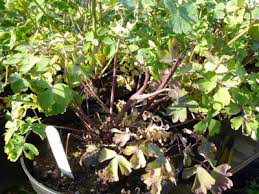 This disease has an incredible virulence that spreads at almost the speed of light. Three thousand plants in the spring of 2014 down to twelve by November 2015. Phenomenally scary.
This disease has an incredible virulence that spreads at almost the speed of light. Three thousand plants in the spring of 2014 down to twelve by November 2015. Phenomenally scary.
So far, no one has been able to determine where this disease has come from. But theories are being hypothesized.
Certainly the genetic analysis has proved Aquilegia downy mildew to be a brand new disease. (It has yet to receive a Latin species name…sufficing with just being placed in the Peronospora genus for now.)
Could this Aquilegia downy mildew possibly be a cross between two other downy mildew forms?
Or could it possibly have entered the UK from another country…one which has not yet properly identified the disease within its borders?
The mystery remains unsolved….although it is my theory the first scenario is the likeliest. Many fungi and viruses are very adept at crossing and producing new forms. Or mutating…which is another possibility.
One thing is for sure…this disease is classified as a terminal disease. There is no cure.
There is some good news to share, however. I have been unable to find any reports this disease has been found in North American…either in Canada or the United States. BUT…this is not to say Aguilegia downy mildew (ADM) is not here and has just not been properly identified yet.
Disease biology and symptoms to watch for
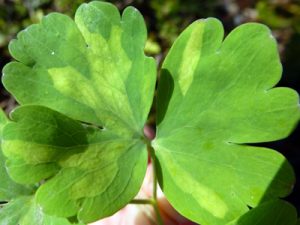 Carrie stated she was fooled into thinking her columbines were suffering from the overly wet and cool spring they had in 2013. But in 2014, when the weather was more normal, she realized there was something going on when more of her columbines were showing signs of disease,
Carrie stated she was fooled into thinking her columbines were suffering from the overly wet and cool spring they had in 2013. But in 2014, when the weather was more normal, she realized there was something going on when more of her columbines were showing signs of disease,
The symptoms she noticed initially were regular pale yellow patches on the upper side of the leaves. These patches were noticeably different from the typically irregular lines of normal leaf variegation. On diseased leaves the patches had fairly straight lines which followed alongside the leaf veins.
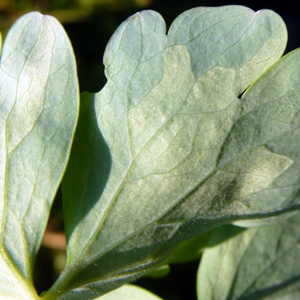 Carrie also noted there is little sign of the mildew infection on the underside of a diseased leaf. The normal progression of a downy mildew fungus is it grows inside the leaf…between the upper and outer layers…and works its way right into the individual cells of the leaf. This is what differentiates downy mildew from powdery mildew. And what makes downy mildews so deadly because of their attack on cells which affects a plant’s growth. (Damping off is another downy mildew species.)
Carrie also noted there is little sign of the mildew infection on the underside of a diseased leaf. The normal progression of a downy mildew fungus is it grows inside the leaf…between the upper and outer layers…and works its way right into the individual cells of the leaf. This is what differentiates downy mildew from powdery mildew. And what makes downy mildews so deadly because of their attack on cells which affects a plant’s growth. (Damping off is another downy mildew species.)
When weather conditions meet downy mildew’s criteria…warm and moist…the fungi begin to grow out through the stomata (pores) on the underside of the leaf and begin to spread. This will appear as a fluffy-like growth, but you may need a magnifying glass, or a macro lens on your camera, in order to see it properly.
Once the mildew fungi are on the outside of the leaf, they produce sporangia…receptacles in which asexual spores are produced. These spores then drift on the wind, or are carried in droplets of rain or dew, which will land on other leaves. If the neighbouring plant happens to be a columbine, the downy mildew spores will germinate and grow through a stoma to begin infecting that plant.
(Note: Apparently, these asexual spores are released only at night. An interesting phenomenom.)
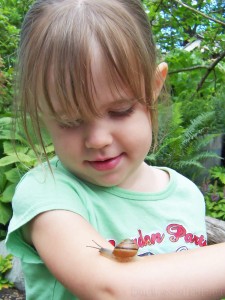 In the event, the spores do not land on any plants and fall onto the soil, they are capable of surviving in a dormant state until a columbine plant begins to grow nearby and the weather conditions are right. Unfortunately, Aquilegia downy mildew is so new, no one knows exactly how long these particular spores can survive in a dormant state in the soil. But according to the Royal Horticultural Society, other downy mildews are capable of surviving in the soil for at least five years.
In the event, the spores do not land on any plants and fall onto the soil, they are capable of surviving in a dormant state until a columbine plant begins to grow nearby and the weather conditions are right. Unfortunately, Aquilegia downy mildew is so new, no one knows exactly how long these particular spores can survive in a dormant state in the soil. But according to the Royal Horticultural Society, other downy mildews are capable of surviving in the soil for at least five years.
One final clue to share on how to identify Aquilegia downy mildew…if you spot slimy slug or snail trails on your columbine leaves, chances are you have a diseased plant. These two slimy gastropods normally do not touch columbines because of the plant’s toxicity. However, they will feed on the downy mildew fungus that grows on the leaves. Fungi are some of their favourite foods.
What to do if your aquilegias are infected
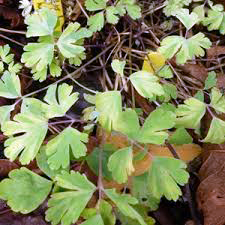 If you do find one or more infected columbine plants in your garden, immediately dig them up and bag them for the garbage. (I would recommend putting a bag over top of the plant before you dig it up in order to, hopefully, control any spores from spreading.) Do not put them in your compost! While this disease, to date, has only infected columbine plants, it is not too large a stretch of the imagination to hypothesize this pathogen could possibly mutate to make it compatible with another plant species in order to keep itself alive.
If you do find one or more infected columbine plants in your garden, immediately dig them up and bag them for the garbage. (I would recommend putting a bag over top of the plant before you dig it up in order to, hopefully, control any spores from spreading.) Do not put them in your compost! While this disease, to date, has only infected columbine plants, it is not too large a stretch of the imagination to hypothesize this pathogen could possibly mutate to make it compatible with another plant species in order to keep itself alive.
I hope I have given you fair warning. It would certainly be an almighty shame if we were to lose our Granny’s bonnets. Some of us do indeed have columbines grown from seed from our grandmother’s plants.
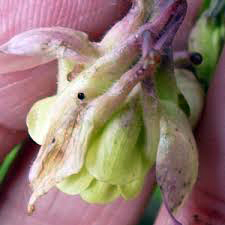 One last item I have not touched on…
One last item I have not touched on…
It is not absolutely clear whether Aquilegia downy mildew can infect the seeds of an infected plant. Some plant pathologists seem to think it does not and the seeds are safe to germinate. However, other plant pathologists theorize ADM is capable of systemically infecting the seeds since the disease does spread to the stems and flowers on an infected plant.
So for my money, I would be hesitant to collect seeds from an infected plant. Far better to err on the side of caution when it comes to a virulent terminal disease.
Note: Check back very soon for my next blog on Impatiens downy mildew (IDM). This article will be posted in the next day or two.
